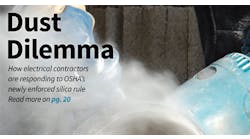A cable pull isn't something you want to repeat in the near future, but certain mistakes can ensure that's exactly what you'll be doing. When you replace cables in a repair situation, there's often pressure due to a limited downtime window and managers hovering around. You'll save time by not hurrying, because you'll have to do the cable pull once. Here's a list of some key tips to keep in mind when doing this type of work:
- Inspect the raceway before installing new cabling. Look for sharp edges at each access point of the pull (e.g., pullboxes). Ensure the raceway is securely supported.
- Inspect the cable. Ensure you have the right cabling and enough length of each type for a given pull.
- Test the cable. For critical cables, perform insulation resistance tests before and after the pull.
- Warm it. In an emergency repair situation, you don't have time to let cables warm up to an optimum pulling temperature. However, cold cables are typically brittle, and even minimal pulling force can be enough to damage the insulation. To avoid damage, aim a forced air heater at the spool(s) and pull slowly. The air blowing across the cable should feel warm, not overly hot, to humans. This process will also help dry the cable.
- Waste lube. Cable lube is cheap. Cables are not.


